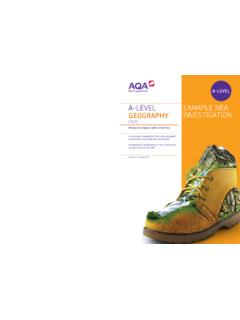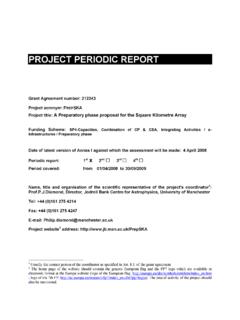Transcription of Guidelines for the Management of Sepsis (including ...
1 Guidelines for the Management of Sepsis ( including neutropenic Sepsis ) Doc Ref: CP38 Version Page 1 of 22 Guidelines FOR THE Management OF Sepsis ( including neutropenic Sepsis ) Procedure Reference: CP38 Version: Document Owner: Dr P Haji-Michael Accountable Committee: Acute Oncology Group Date Approved: 15/05/2013 Review date: Jan 2019 Target audience: Greater Manchester & Cheshire Cancer Network All clinicians Guidelines for the Management of Sepsis ( including neutropenic Sepsis ) Doc Ref: CP38 Version Page 2 of 22 CONTENTS 1. ASSOCIATED DOCUMENTS.
2 3 2. INTRODUCTION .. 3 Purpose .. 3 Scope .. 3 3. DUTIES .. 3 4. Management OF FEBRILE CANCER PATIENTS .. 3 5. DEFINITIONS .. 4 Definitions of ' Sepsis ' and 'Systemic Inflammatory Response Syndrome' .. 4 Definition of neutropenia .. 4 6. CLINICAL ASSESSMENT OF THE SEPTIC PATIENT .. 4 Initial assessment .. 4 History and examination .. 5 Investigations .. 6 Follow up assessment .. 7 7. INITIAL TREATMENT .. 7 Who to treat .. 7 Definitions of high and low risk patients with neutropenia .. 7 Empirical treatment of high risk septic patients.
3 8 Treatment of low risk patient oral antibiotic regimen .. 8 8. REASSESS AT 48 HOURS .. 9 9. IF STILL FEBRILE AT DAY 4-6 .. 9 10. DURATION OF ANTIBIOTICS .. 10 11. COMMON MODIFICATIONS TO INITIAL EMPIRICAL TREATMENT .. 10 Specific treatment for C. difficile diarrhoea: .. 12 12. REMOVAL OF INTRAVENOUS LINES .. 14 13. ALLOGENEIC BONE MARROW TRANSPLANT PATIENTS .. 15 14. USE OF ANTIVIRAL DRUGS .. 15 15. THE ROLE OF PROPHYLACTIC ANTIMICROBIALS AND OTHER AGENTS .. 15 16. EMPIRICAL TREATMENT - SUITABLE IV ANTIBIOTIC REGIMENS .. 15 17. CONSULTATION, APPROVAL & RATIFICATION PROCESS.
4 16 18. PROCESS FOR MONITORING EFFECTIVE IMPLEMENTATION .. 16 19. REFERENCES .. 17 20. VERSION CONTROL SHEET .. 18 21. APPENDICES .. 19 Guidelines for the Management of Sepsis ( including neutropenic Sepsis ) Doc Ref: CP38 Version Page 3 of 22 1. ASSOCIATED DOCUMENTS Guidelines for Hand Hygiene Standard Precautions policy Patient Isolation policy Guidelines for Aseptic Technique Sepsis Resuscitation Bundle Guidelines for Management of Severe Sepsis and Septic Shock NCP - Care plan for the patient with neutropenia / neutropenic Sepsis 2. INTRODUCTION From 2012 onwards, Acute Oncology teams at all acute Trusts and the Christie will support the care of cancer patients who present as an emergency, especially those on current or recent treatment.
5 For patients undergoing treatment for cancer, all infective episodes need to be rapidly assessed and treated urgently with antibiotics. Purpose To adhere to NICE and Peer review Guidelines Scope This document applies to all clinical staff. 3. DUTIES The Acute Oncology Group is now responsible for this document, under the direction of Dr P Haji-Michael. 4. Management OF FEBRILE CANCER PATIENTS All Christie-registered patients on chemotherapy treatment will have been issued with an information card which will detail information about their chemotherapy regimen and the recommended empiric antimicrobial treatment.
6 This will also provide an immediate contact number which may be the chemotherapy team (in working hours) or the Christie Acute Oncology Management Service (AOMS) incorporating the Hotline. The latter provides 24 hour advice, 7 days / week to patients and professionals. For patients under treatment at The Christie seen in other Trusts, the AOMS should be contacted on 0161-446-3658 for advice on how to manage the patient locally or referral back to the centre. Clinicians may also seek advice from the responsible oncology team and additional microbiology advice from the local or Christie microbiologist if needed.
7 Up to 60% of febrile neutropenic patients prove to have infections and 16-20% of those with a neutrophil count <100/mm3 have a bacteraemia. Fever is commonly as a result of bacteraemia and usually due to Gram positive cocci ( coagulase negative staphylococci, Staphylococcus aureus, viridans streptococci) or Gram negative bacilli ( Escherichia coli, Klebsiella spp, Pseudomonas aeruginosa etc). Fungal infections tend to occur after patients have received broad-spectrum antibiotics and have had prolonged periods of neutropenia but may present as primary infections.
8 Infections in neutropenic patients typically take 2-7 days to respond to antimicrobial therapy. Acute respiratory viral infections influenza or respiratory syncytial virus may be associated with severe illness in the immunocompromised host. Guidelines for the Management of Sepsis ( including neutropenic Sepsis ) Doc Ref: CP38 Version Page 4 of 22 Fever may be absent in some infected patients who are dehydrated, severely shocked (see below), taking steroids or NSAIDs. The possibility of infection must be considered in any patient undergoing treatment for cancer who is unwell and particularly in those who are neutropenic .
9 Conversely fever may be a complication of non infectious causes transfusion, drugs such as cytarabine, and malignant disease such as lymphoma and renal carcinoma. 5. DEFINITIONS Definitions of ' Sepsis ' and 'Systemic Inflammatory Response Syndrome' Patients are often described as being "septic" or having "septic shock". These terms are used in a variety of ways by different doctors and in 1992 ' Sepsis ' and several new terms were formally defined: Systemic inflammatory response syndrome (SIRS) replaced the previous term ' Sepsis syndrome'.
10 This is the body's response to a variety of severe clinical insults. It is characterised by the presence of two or more of the following features: o Temperature 38 C or above or <36 C o Heart rate > 90/min o Respiratory rate > 20/min or PaCO2 < o White cell count <4 OR >12 x 109/l Sepsis is defined as SIRS in response to infection. Severe Sepsis is Sepsis associated with: o organ dysfunction (altered organ function such that normal physiology cannot be maintained without support) o hypotension (systolic blood pressure < 90mmHg or a reduction of > 40 mmHg from the patient's normal in the absence of other causes of hypotension) o organ hypoperfusion (revealed by signs such as lactic acidosis, oliguria, acute alteration of mental status).







